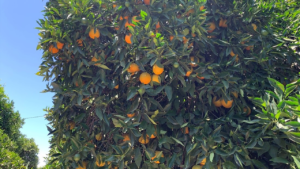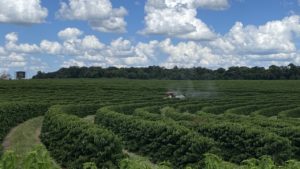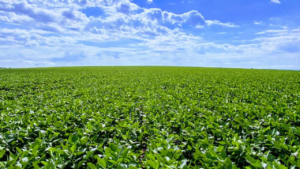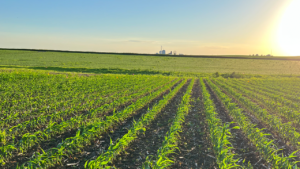Despite all the technology developments and scientific breakthroughs, critical crop production issues continue to plague growers around the world. A recent review of production challenges with the AgriThority Board of Advisors raised five issues including citrus greening, fusarium wilt, coffee rust, sustainability validation and carbon sequestration.
-
-
-

Citrus greening on Valencia orange fruits in an orchard grove in Woodlake, CA. Citrus Greening threatens citrus production – particularly oranges — in most areas of the world and currently has no cure. This disease is caused by a bacterial infection transmitted by Asian citrus psyllid feeding on leaves and stems. While not harmful to humans, the disease kills citrus trees. According to The New York Times, this is the most devastating citrus disease that affects both commercial farmers, as well as residential citrus. The disease arrived in Florida in 2005 and has cost the citrus industry more than $1 billion. The $2 billion citrus industry in California has been affected since 2008. In May, two Florida members of Congress submitted a bipartisan letter to the U.S. Environmental Protection Agency to fast track a biochemical pesticide to fight citrus greening.
- Fusarium wilt is the most destructive fungal disease affecting banana plantations around the globe caused by a soilborne fungal that disrupts the flow of nutrients from roots to the upper plant parts. Management strategies control the spread of Fusarium wilt, but do not provide long-term solutions. Once an area is invaded, it is almost impossible to grow bananas. Recent technologies may lead to Fusarium-resistant banana varieties, but until then this infection remains a long-standing threat to production.
-

Grower spreading a fungicide application for coffee rust on a field in in Paraná, Brazil. Coffee Rust threatens this morning staple. Recently discovered in Hawaii in 2020, the coffee leaf rust is caused by a fungus. The damage to coffee trees across Central and South America has cost billions since 2011. Work is underway to develop fungicides based on the disease’s genetic weaknesses while breeders are generating cultivars with resistance to the fungus.
- Sustainability validation process for production systems is evolving though guidelines were generated by Food and Agriculture Organization of the United Nations (FAO) in 2014. The Sustainability Assessment of Food and Agriculture Systems (SAFA) is intended to set a harmonized framework for consistency, applicability and transparency for production enterprises, NGO communities as well as governments, investors and policymakers. In the U.S., environmental sustainability laws include the Clean Water Act; Clean Air Act; Endangered Species Act; Insecticide, Fungicide and Rodenticide Act; and the Lacey Act. Specific to the biotechnology realm, the U.S. has a coordinated framework to ensure the safety of genetically modified crops that is regulated by three federal agencies. What’s evolving is how or why producers are changing their production systems. Who is incentivizing growers and how will their operations improve?
- Measurements and value generation for carbon sequestration need to be standardized and more widely understood and accepted. Measuring Carbon sequestration occurs in several ecosystems and in several methods. Scientific experts from various fields have put together specific guidelines in an International Panel on Climate Change to measure Carbon sequestered, principally using mathematical models. Chapter 7 of the report covers Agriculture, Foresty and other Land Uses.
-
-

While these broad international issues remain challenging, many technologies are evolving food, feed, fuel, and fiber production techniques that offer alternative solutions for growers. As harvest was wrapped up in the Southern Hemisphere, the AgriThority team analyzed a broad range of innovative technologies in various stages of product development. Since 2008, the scientists of AgriThority have worked with researchers to develop products across all categories of production inputs for more than 60 crops.
The primary category of significance is biologicals, with biofertilizers gaining momentum along with biocontrols. Typically defined as inoculants, this product category now includes microbial products with impact on nutrient uptake or use within plants, and not just legumes and not just nitrogen-fixation. The nutrient use enhancements include P solubilizers, K mobilizers, and others impacting microelements. Differentiating between biofertilizers and biostimulants is not always clearly defined since both impact plant health without pest control claims.
While legumes were the only crop benefiting from inoculant/biofertilizer for decades, the expansion of this segment includes microbial biostimulants with mycorrhizae and other microbials mainly based on Bacillus. Within legumes, the primary crop is soybean. This biofertilizer segment is now one of the most innovative and rapidly growing around the world due to the nitrogen-fixing microbials for other crops. Use of Azospirillum was among the first commercialized N-fixation products in Brazil and other parts of LATAM. Adoption of the n-fixing microbials is expanding across other continents and for other crops, including corn. Many new biofertilizer products in development may soon give growers more alternatives to traditional fertilization systems. With ever-increasing prices, more growers may become early adopters of novel approaches to plant nutrition. Aiding this evolution are the changing regulatory policies, especially in Europe with their Farm-to-Fork strategy and the U.S. is catching up with recent clarity of definitions.
The Plant Biostimulant Act of 2022 in the U.S. amends the Federal Insecticide, Fungicide, and Rodenticide Act (FIFRA) to:
-
-
- establish a federal definition for a plant biostimulant,
- exempt plant biostimulants from regulation under the Federal Fungicide, Insecticide and Rodenticide Act (FIFRA). [Note: The Act also provides a definition for a “nutritional chemical” a product category historically exempted from FIFRA regulation, but, to date, not defined and an updated definition for “vitamin hormone products, that reflect their current usage”], and
- authorize the Secretary of Agriculture to conduct a soil health study regarding plant biostimulants, as defined in the PBA, to assess and recommend best management practices that will promote soil health and several other environmental and agronomic benefits.
-
Under the PBA, plant biostimulant means a substance, microorganism, or mixture thereof, that, when applied to seeds, plants, the rhizosphere, soil, or other growth media, act to support a plant’s natural processes independently of the biostimulant’s nutrient content, including by improving nutrient availability, uptake or use efficiency, tolerance to abiotic stress, and consequent growth, development, quality, or yield.
Establishing a clear path to market for biostimulants will help to move these innovative agricultural products into the hands of growers which will help to improve plant health, crop yield, and tolerance to abiotic stresses.
AgriThority® has Boots on the Ground evaluating production technologies in more than 60 crops around the world through small plot or large-scale field trials. In 2022, the early or late development testing programs range from biofungicides, bioherbicides, bioinsecticides, bionematicides, bionutrients and biostimulants to conventional fertilizers, herbicides, inoculants, plant genetics and soil amendments. Other work includes measuring soil salinity reduction, methane gas emissions and soil carbon.

With NORAM and Europe in mid-season, we encourage clients to consider incorporating counter season programming into a stage gate development process as Southern Hemisphere planting time approaches. Using this second season builds the database and insights to rapidly prove the value of a new technology. Counter season trials accelerate the generation of product efficacy data by validating the product value across a wider range of environments. This also can be a step toward future market access in new geographies.
Help to move your innovation to market or hear more about our capabilities, reach out to AgriThority today. Our international footprint, combined with our deep understanding of market and producer dynamics, helps you to leap hurdles and overcome barriers to set up your products for success.




